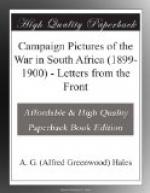By-and-by the rifle fire on our left flank grew weaker and weaker—our guns were searching the kopjes with merciless accuracy—and before sundown it died away altogether, and we had time to collect our wounded and ascertain our losses, though we could not even guess how the Boers had fared Our wounded amounted to eight men all told, none of them dangerously hurt; of dead we had none, not one. When their fire slackened the enemy doubtless expected to see an onward dash of troops from our position, but it was not to be. General Rundle had decided to play “patience” and save his men; there was no necessity for him to rush on and force the Boer position, and he chose the better part. Steadily our fellows were worked into position, until every bit of ground that could bear upon the foe was lined with British troops. Every available point, front or flank, where a gun could be placed to harass the foe was taken advantage of; nothing was left to chance, nothing was rashly hurried. Carefully, methodically the work was done. There was to be no carnival of death on our side, no trusting to the “luck of the British Army,” no headlong rush into the arms of destruction, no waving line of bayonets. The Boer was to play a hand with the cards he loves to deal He was to be shelled and sniped. If he wanted straight-out fighting, he had to come out into the open and get it. He was to have no chance to sit in safety and slaughter the British soldiers like shambled deer, as he had so often done before. As the sun went down our men bivouacked where they stood, and nothing was heard through the long, cold night except at intervals the grim growling of a gun, the sentinels’ swift, curt challenge, or the neighing of horses as steed spoke to steed across the grass-grown veldt.
At the breaking of the dawn I was aroused from sleep by the simultaneous crashing of several of our batteries. It was Britain’s morning salutation to the Boer. I hurried up to a spot on the kopje where a regiment of Worcesters lay amongst the broken ground, and saw that the battle was just about to commence in deadly earnest. It was a huge, flat-topped kopje where I located myself. The outer edges of the hill rose higher than the centre, a little rivulet ran across tiny indentations on the crown of that rampart, and there was ample space for an army to lie concealed from the eyes of enemies. If the Boers were strongly posted, so were the British. Away past our right flank Wepener range was plainly visible in the clear morning light, and just behind Wepener lay the Basuto border, with its fringe of mountains. About two thousand yards away, directly facing our centre, a white farmhouse stood in a cluster of trees. This farmhouse gave the battlefield its name, Constantia Farm. The enemy could be seen by the aid of glasses slipping from the kopjes down towards this farm and back again at intervals. Cattle, horses, goats, and sheep went on grazing calmly, the roaring of the guns doubtless seeming to them but as the tumult of a storm.




